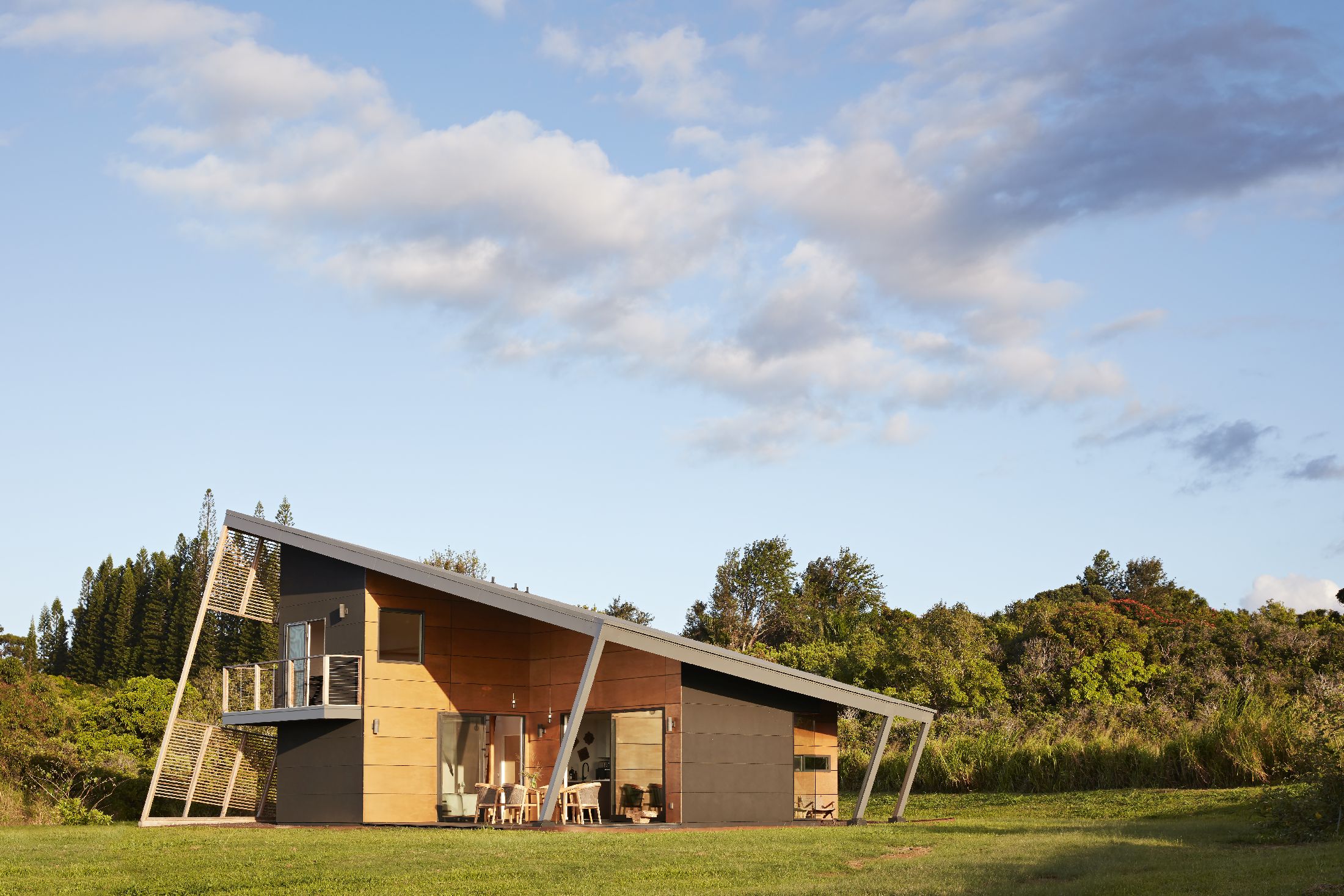Spiegel Aihara Workshop (SAW) has designed the Kauhikoa Core House on the island of Maui, a two-bedroom home that appears as a tumbling set of forms settling gracefully into the landscape of its site, a former pineapple plantation.
The house was conceived of by SAW as a “prefabrication hybrid”: a concept that starts with a standardized central core for a home’s most technically complex and traditionally expensive functions, such as bathrooms and mechanical equipment, and allowing for different methodologies of prefabrication or conventional framing to be built around it, freeing up the rest of the structure to respond simply and directly to its context.
While Kauhikoa Core House was ultimately stick-built due to pandemic-related interruptions to the pre-fabrication process, the home is a successful prototype for the organizational principle of the “Core House” and the ease and efficiency it provides.

The 812-square-foot home was built for a couple who splits time between Indonesia and Maui. It contains two bedrooms, two bathrooms, living room and kitchen, an additional 236 sq feet of lofted work and storage space as well as an additional 1000 square feet of covered outdoor space, including a large lanai that functions as an outdoor living room connected to continuous smaller lanais. The 163-sf Core module, developed by SAW in collaboration with Dustin Stephens, holds the two bathrooms, kitchen sink and cabinetry wall, and mechanical systems; and is flanked by the two bedrooms on either side, centering the open kitchen and living spaces.
The careful arrangement of domestic service functions within the cohttps://i.ibb.co.com/HXDckQM/B.jpgre helps to choreograph and maximize open space and easy circulation throughout the rest of the home, and particularly allows for the distinct framing of the outdoor spaces as central to the couple’s lifestyle and supported by the Hawaiian climate.

Says SAW co-founder Dan Spiegel, “The super-compact Core programs each room, just by its adjacency. It carries the DNA of the functions of the adjoining space. There’s no need for anything in between – no hallways, no buffered transitions just spaces of inhabitation, always embedded in the landscape on 3 sides.”
A striking, modularized screen system of rhythmically tapering pre-fabricated teak panels assembled in Bali, filters the strong eastern winds and morning sun, while providing a racking system for the implements of Hawaiian life: bicycles, surfboards, wetsuits, and beach chairs beside the outdoor shower, which is used as the primary shower.

The shed roofs of the house and an adjacent freestanding 438-square-foot garage and recreation pavilion, are tilted off their axes like tumbling cubes, their forms playing off of one another to resemble a mountain landscape.
For the house, the resulting roof overhang provides for the simple construction of the multiple continuous lanais, connected across the common space, and allowing for the lofted work space in the primary bedroom (with a balcony to capture the view), a storage loft integrated into the top of the Core, and the private, intimate, and the fully separable guest suite towards the low end of the slope, shielding the southern sun. All indoor and outdoor furniture, provided by the homeowners, were custom-made in Indonesia.

In the context of the landscape, the house perches towards the back corner of the lot against the densely forested edge of a gully, directing the primary living spaces outwards to views of the Pacific Ocean and Haleakala volcano in opposite directions, and opening up towards the sunset in the west. Its unique massing, the aforementioned tumbling set of forms, references the abstract movement of waves on the horizon.
“The landscape here is so dynamic,” describes SAW co-founder Megumi Aihara. Standing on the site, you can start to feel how the winds and waves carved and faceted the island from all directions. We felt it was important for the building to feel rooted, but also playfully engaging in this multi-directional transformation. The approach from the street suggests something unusual had settled there into the landscape. Then when you turn along the driveway, the building opens up to you and you see how it has come to deeply belong.”

On Maui, where a scarcity of materials, limited labor, and construction complexity due to erratic weather can lead to expensive, low-quality housing stock, the Kauhikoa Core House is an example of an inexpensively built home that responds elegantly and progressively to its context, providing a model for high-quality design at an affordable price. Ultimately, says SAW co-founder Dan Spiegel, “It’s a mix of high and low design – carefully calibrated spaces and site strategy, but low cost finishes and loose details. A few big, simple moves set everything up.”
One of the homeowners, an avid surfer with an intrepid mindset, served as the general contractor and constructed much of the work himself. Enthralled by the process of reading the Hawaiian landscape through collaboration and design, he is now pursuing a graduate architecture degree at the University of Hawaii.

Other images can be seen in the gallery down below
Project Data:
Architecture / Landscape Architecture: SAW
Core Collaborator: Dustin Stephens
Structural Engineer: GFDS (Chris Wilson)
General Contractor / Client: Jez Fry
Photography: Mariko Reed and SAW
Products:
Marine Grade Plywood Exterior Panels
Fleetwood Door/Window
Milgard Trinsic windows
Custom Teak Panelized Screen
Custom Teak Furniture
Standing Seam Metal Roof
Cast In Place Concrete
About SAW
SAW is a transdisciplinary design firm, operating at the nexus of architecture, landscape, and urban design.
This mix allows us to work across scales (from the tactile object to the city) and timelines (from the immediate to the ecological) at the onset of a project. We work to identify the blind spots between disciplines and take advantage of the hidden opportunities therein. We believe in the transformative power of good design, in the inextricable relationship between building and context, and in the vital role the built environment plays in the development of community. We view design as a collaborative, research based process, and work closely with clients to better understand their needs and advance their goals.
Dan Spiegel, AIA
Founding Partner, Principal
Dan received a Master of Architecture from the Harvard University Graduate School of Design and B.A. in Public Policy from Stanford University. Prior to founding SAW, Dan worked for a number of leading architecture offices in New York, Beijing, and Boston. He currently teaches architecture at UC Berkeley and California College of the Arts (CCA) and has been an invited design critic at several schools of architecture, including Harvard University, Rhode Island School of Design, and California College of the Arts. Dan is a licensed architect in the states of California and Hawaii.

Megumi Aihara, ASLA, PLA
Founding Partner, Principal
Megumi has ten years of professional experience creating landscapes, big and small. Prior to joining SAW, Megumi was a Senior Project Manager at Michael Van Valkenburgh Associates, and a Landscape Architect with Andrea Cochran Landscape Architecture. Megumi received a Master of Landscape Architecture from the Harvard University Graduate School of Design and a B.A. in Visual Arts from Brown University. She is an Adjunct Professor of architecture at California College of the Arts (CCA). Megumi is a licensed Landscape Architect in the states of California and Hawaii.
Jeremy Ferguson, Associate
Jeremy received his Master of Architecture from the University of California at Berkeley where he was the recipient of The Mario Ciampi Art in Architecture Award demonstrating outstanding artistic merit. Originally from Hawai’i, he received his his Bachelor of Arts in Environmental Design from the University of Hawai’i at Manoa before moving to the Bay Area. His other professional experience includes positions at MODEM in Oakland, Randolph Designs in San Francisco, Dean Sakamoto Architects in Honolulu, and the National Disaster Preparedness Training Center at the University of Hawai’i.
Sharon Ling, Associate
Sharon received a Louisiana ASLA student honor award in 2015 before earning her Masters in Landscape Architecture from Louisiana State University. Originally from China, Sharon holds a Bachelor degree of Landscape Architecture from Nanjin Forestry University.
Namhi Kwun
Namhi received the San Francisco CSI Foundation award in 2017 before earning her Bachelor of Architecture degree from the California College of the Arts. Her other professional experience includes positions at Urban Works Agency, Mark Cavagnero Associates in San Francisco, and The Plus Architect in Korea.
Avery Sell
Avery is a landscape designer educated at the Pennsylvania State University Stuckeman School of Architecture and Landscape Architecture where he received an ASLA Student Honor Award and was named the 2014 Student Marshall. He brings to every project ideas that blend the mundane and the extraordinary, social science and sustainability, and past and future histories. Prior to moving to San Francisco, Avery worked in Philadelphia as a creative consultant, an artist’s assistant, and as a project manager at David Rubin Land Collective.
Shinji Miyajima
Shinji is an international designer from Japan and received his Master of Architecture from Rice University and Bachelor of Science in Architecture from the University of Cincinnati. Prior to joining SAW in January 2021, he worked at architecture and architectural lighting design offices in New York, San Francisco, Los Angeles, Dallas and Houston.
Tiffany Xu
Tiffany Xu is an architectural designer. She earned her Master of Architecture from Rice University where she was Co-Editor-in-Chief of PLAT Journal and recipient of the William D. Darden Thesis Award. She completed a B.A. in Natural Resource Conservation and Art History from University of California, Berkeley. Prior to joining SAW she worked at the offices of Jim Jennings Architecture, Sidell Pakravan, and Mollet Geiser & Co.

